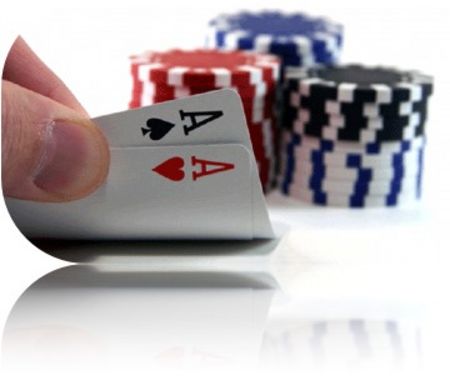The Flop

The flop is a defining moment in Texas Hold'em. It is important to determine right
away if your hand has value before you start committing chips to the pot. Many
players consider the turn to be a more important round of betting since it is more
expensive, but it is often the mistakes you make on the flop that create further
mistakes on the turn and river. For example, if you make a weak draw on the flop
and hit it on the turn only to lose to a better hand, it was probably a mistake on the
flop that led you to lose several bets.
Lets look at the most important considerations you should evaluate on every flop.
- The strength of your hand - How strong is your hand? Does it need to be
protected? Can you slowplay? If you are drawing, how strong of a draw do
you have? Each type of hand has its own chapter to discuss the
considerations and strategies you might use.
- The type of flop - How strong is your hand relative to each type of flop? In
general, the following types of flops are dangerous unless they give you a
very strong hand: all high cards, a high or low pair, three-suited, and three-
connected. Two-suited flops or two related high cards also present dangers
that require you to fold most of your weak draws. Later in this chapter we will
discuss each type of flop in more detail.
- Number of opponents - The more opponents you are against, the higher the
chance an opponent has a strong hand. Against three or more opponents,
you should normally assume that an opponent has a strong hand if they bet;
therefore, against multiple opponents you need to limit your play to either
strong hands or strong draws (unless the pot is very large, in which case you
might be able to call with weak draws). You can consider bluffs and semi-
bluffs against one or two opponents since there is a chance that no one has
been helped on the flop. Bluffs against three opponents rarely work and are
not recommended against four opponents.
- Possible hands of opponents - You should try to determine the possible
hands of your opponents based on their positions, the preflop betting, and
the betting so far on the flop. Once you have an understanding of their
possible holdings you can determine the relative strength of your own hand.
Remember, the more players there are in the pot the more likely it is that
someone has a strong hand such as a set or two pair. One important
consideration when you are drawing is to evaluate the possibility that your
draw is counterfeited. When you draw and hit your hand you want to win!
- The pot size - The size of the pot can have a big impact on the strategy you
choose. When you have a very strong hand, you can .sometimes slowplay
when the pot is small, but should play it strongly when the pot is large. The
pot size may dictate how you try to protect a vulnerable hand. Larger pots
give you better pot odds to make more draws than small pots. Always be
aware of the size of the pot when making decisions.
- Cost/Potential cost of bet - Paying two bets can decrease your pot odds a lot.
Always evaluate your position relative to the remaining players in the pot.
Many times you need to fold hands that you would otherwise call when there
is the possibility of a raise behind you. For example, when an early position
player bets and you must act with a gut-shot draw, you should usually fold if
there are many players behind you who could raise.
 With every flop, you should go through some basic thought processes. First,
evaluate the type of flop and then the strength of your hand relative to that flop.
Next, compare your hand to the possible hands of your opponents. Finally,
determine your best strategy based on the pot odds you are receiving. On the
Internet you have about 20 seconds to evaluate all this information and make your
decision!
With every flop, you should go through some basic thought processes. First,
evaluate the type of flop and then the strength of your hand relative to that flop.
Next, compare your hand to the possible hands of your opponents. Finally,
determine your best strategy based on the pot odds you are receiving. On the
Internet you have about 20 seconds to evaluate all this information and make your
decision!
Let's look at some examples to show how top pair can cither be a strong hand or
very weak depending on the type of flop. Notice how A ♦ T ♣ changes in value
depending on the flop.
T ♦ 5 ♥ 2 ♣. This is a very good flop for A ♦ T ♣. You have top pair with the best kicker.
There are no flush or straight draws available to your opponents.
T ♦ 5 ♥ 2 ♥. This is a good flop also, but now you could be against a flush draw.
T ♦ 5 ♥ 5 ♣. Whenever a pair comes on the flop and you don't have trips or a full
house, you should proceed with caution. The risk is dependent on the number and
position of the callers. If you are against a strong early position player, a T55 flop
should not be too dangerous. If there are five callers in the pot including the two
blinds, then a T55 flop would greatly diminish the value of your top pair.
T ♦ 9 ♥ 9 ♣. This flop also has a pair but now there are even more problems. The pair
is relatively high, so it is more likely that a player would be holding a 9 than a 5.
Many players will play J9, T9, Q9s, etc., whereas they generally fold hands with 5.
The flop is also two-connected, so you could be against a straight draw.
T ♥ 9 ♥ 9 ♣. Add a flush draw to this very dangerous flop.
T ♦ 9 ♥ 8 ♣. Another very dangerous flop. You could already be against a straight or
at least a good straight draw. Hands such as KJ, AJ, KQ, and QJ are all dangerous
hands to your pair. You should probably fold if you are against several opponents
and one or two of them are showing a lot of aggression.
T ♥ 9 ♥ 8 ♣. Add a flush draw to make this flop even more dangerous.
T ♥ 9 ♥ 8 ♥. Can it be any worse? You have top pair but must worry about flushes,
straights, and overcards. If you are not already beat and drawing dead, any heart,
K, Q, J, 9, 8, 7, or 6 could be bad news.
Let's look now at the main types of flops and the qualities and considerations of
each, The purpose of this introduction to flop types is to help begin the thought
processes that you should go through with each type of flop. The following chapters
will look at each type of hand in more detail and the best strategies to use with the
various flop types. Some of these flop types can be intertwined. For example, a flop
with a high pair and a rag could also be two-suited, but these are discussed
separately.
The main types of flops are as follows:
- Three of a Kind
- High Pair
- Low Pair
- Two-Suited
- Three-Suited
- Two-Connected
- Three-Connected
- All High Cards
- Rainbow with One High Card
- Rainbow of All Rags
NEXT...Three of a Kind

